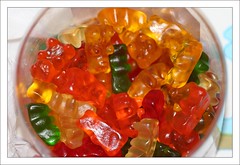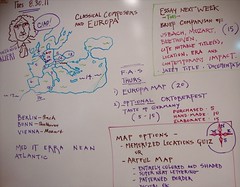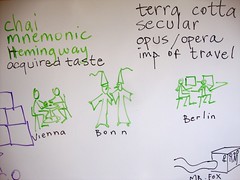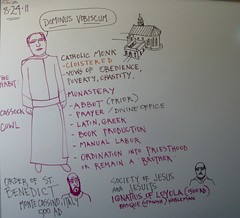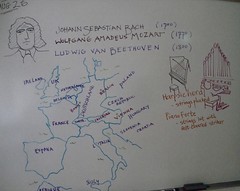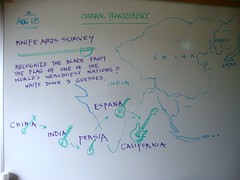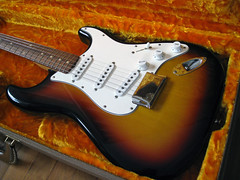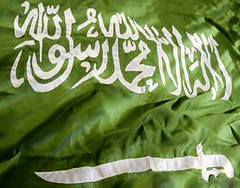Lizzie Martin emailed me that Gummi Bears were developed in Germany. Thus in addition to bratwurst, pretzels and German chocolate cake, we will have Gummi Bears at the Taste of Germany.
Here's what Wikipedia reveals:
"The gummi bear originated in Germany, where it is popular under the name Gummibär (rubber bear) or Gummibärchen (little rubber bear).
Hans Riegel Sr., a candy maker from Bonn, started the Haribo company in 1920. In 1922, he invented the Dancing Bear,[1] a fruit-flavored gum made in the shape of a bear.[2] The success of the Dancing Bear's successor would later become Haribo's world-famous Gold-Bears candy product in 1967.[3]
Trolli is another gummi candy manufacturer and the first to introduce gummi worms in 1981.[4] Gummi bears are also one of the few types of candy to have been turned into a television show.[5]
The success of gummi bears has spawned many gummi animals and objects: rings, worms, frogs, snakes, hamburgers, cherries, sharks, penguins, hippos, lobsters, octopuses, apples, peaches, oranges, and even Ampelmännchen, Smurfs and spiders.
Tuesday, August 30, 2011
Fine arts Taste of Deutschland, Europa map and Comparison essay
Thurs map:
a) memorized
or
b) Artful Map
- entirely colored and shaded
- super neat lettering
- colorful, patterned border (look at antique maps, please)
- 20 identifications
- Jazzy title
- compass rose
- hand-made, digital Not OK.
a) memorized
or
b) Artful Map
- entirely colored and shaded
- super neat lettering
- colorful, patterned border (look at antique maps, please)
- 20 identifications
- Jazzy title
- compass rose
- hand-made, digital Not OK.
Chai, ciao: fine arts vocab / Fantastic Mr Fox
- chai: Asian term for tea
- ciao: Italian for hello or goodbye
- Hemingway: Asked what was essential for a great writer, Ernest Hemingway responded memorably, "A built-in, shock-proof crap detector."
- Mediterranean: from the Latin word mediterraneus, meaning "in the middle of earth" or "between lands" (medius, "middle, between" + terra, "land, earth").
Vienna: coffee shops for discussion of ideas and art. "Viennese cafés have an extremely long and distinguished history that dates back centuries," says Wikipedia.
Bonn: The home of Beethoven is also the annual site of an enormous crowd celebrating Karneval.
Berlin: modern Berlin seems eclectic in music but has built its recent fame on production of electronica. Ask your uncle about Kraftwerk. Well, ask me about Kraftwerk.
Shreveport Symphony Orchestra opening concert: Sat, Sept 24.
The Fantastic Mr Fox interactive exhibit at Artspace will be visited on a FAS (Fine Arts Survey) field trip. In an unusual turn, the show costs $8 per student.
- mnemonic: memory aid
- acquired taste: Wikipedia says, "An acquired taste often refers to an appreciation for a food or beverage that is unlikely to be enjoyed by a person who has not had substantial exposure to it, usually because of some unfamiliar aspect of the food or beverage, including a strong or strange odor (e.g. stinky tofu, kimchi, haggis, hákarl, black salt, asafoetida, or certain types of cheese), taste (such as bitter teas or natto), or appearance.
Acquired taste may also refer to aesthetic tastes, such as taste in music or other forms of art.
- opus: a musical composition or a literary work or composition, as a book: Have you read her latest opus?
- secular : of or relating to the worldly or temporal b : not overtly or specifically religious c : not ecclesiastical or clerical .
- terra cotta: Italian: "baked earth", from the Latin terra cotta.
- ciao: Italian for hello or goodbye
- Hemingway: Asked what was essential for a great writer, Ernest Hemingway responded memorably, "A built-in, shock-proof crap detector."
- Mediterranean: from the Latin word mediterraneus, meaning "in the middle of earth" or "between lands" (medius, "middle, between" + terra, "land, earth").
Vienna: coffee shops for discussion of ideas and art. "Viennese cafés have an extremely long and distinguished history that dates back centuries," says Wikipedia.
Bonn: The home of Beethoven is also the annual site of an enormous crowd celebrating Karneval.
Berlin: modern Berlin seems eclectic in music but has built its recent fame on production of electronica. Ask your uncle about Kraftwerk. Well, ask me about Kraftwerk.
Shreveport Symphony Orchestra opening concert: Sat, Sept 24.
The Fantastic Mr Fox interactive exhibit at Artspace will be visited on a FAS (Fine Arts Survey) field trip. In an unusual turn, the show costs $8 per student.
- mnemonic: memory aid
- acquired taste: Wikipedia says, "An acquired taste often refers to an appreciation for a food or beverage that is unlikely to be enjoyed by a person who has not had substantial exposure to it, usually because of some unfamiliar aspect of the food or beverage, including a strong or strange odor (e.g. stinky tofu, kimchi, haggis, hákarl, black salt, asafoetida, or certain types of cheese), taste (such as bitter teas or natto), or appearance.
Acquired taste may also refer to aesthetic tastes, such as taste in music or other forms of art.
- opus: a musical composition or a literary work or composition, as a book: Have you read her latest opus?
- secular : of or relating to the worldly or temporal
- terra cotta: Italian: "baked earth", from the Latin terra cotta.
Saturday, August 27, 2011
The beginnings of European music: Monks & monsteries
Gregorian chant - a music codified by Pope Gregory I, about 600 CE - was one of the early musics of the Europeans.
This body of music was the first to be notated in a system ancestral to modern musical notation, says Wikipedia.
In general, the chants were learned by the viva voce method, that is, by following the given example orally, which took many years of experience in the choir called the Schola Cantorum.
Gregorian chant originated in monastic life, in which celebrating the 'Divine Office' eight times a day at the proper hours was upheld according to the Rule of St. Benedict.
Singing psalms made up a large part of the life in a monastic community, while a smaller group and soloists sang the chants.
This body of music was the first to be notated in a system ancestral to modern musical notation, says Wikipedia.
In general, the chants were learned by the viva voce method, that is, by following the given example orally, which took many years of experience in the choir called the Schola Cantorum.
Gregorian chant originated in monastic life, in which celebrating the 'Divine Office' eight times a day at the proper hours was upheld according to the Rule of St. Benedict.
Singing psalms made up a large part of the life in a monastic community, while a smaller group and soloists sang the chants.
JS Bach, Mozart, Beethoven and Europe
Quiz on this vorticular map next week, monsieur et mesdames.
Mozart: Austria
Beethoven: Bonn, Deutschland
JS Bach: region of Berlin, Deutschland
Mozart: Austria
Beethoven: Bonn, Deutschland
JS Bach: region of Berlin, Deutschland
Targeting.gif [animated]: PBS on the wooly world of meme-making
PBS on the wooly world of meme-making. Please see http://www.youtube.com/watch?v=JL7R9CjkxjY&feature=channel_video_title
/>
/>
Tuesday, August 23, 2011
Fireworks and Chinese cultural heritage: contemporary artist Cai Guo-Qiang
Cai Guo-Qiang was born in 1957 in Quanzhou, Fujian Province, China, says Wikipedia.
He was trained in stage design at the Shanghai Drama Institute from 1981 to 1985. Cai's work is scholarly and often politically charged.
See numerous videos of his gunpowder events on Youtube.
Cai initially began working with gunpowder to foster spontaneity and confront the suppressive, controlled artistic tradition and social climate in China. While living in Japan from 1986 to 1995, Cai explored the properties of gunpowder in his drawings, an inquiry that eventually led to his experimentation with explosives on a massive scale and the development of his signature "explosion events". In 1995, he moved to New York.
Cai Guo-Qiang's practice draws on a wide variety of symbols, narratives, traditions and materials such as fengshui, Chinese medicine, shanshui paintings, science, flora and fauna, portraiture, and fireworks.
Much of his work draws on Maoist/Socialist concepts for content, especially his gunpowder drawings which strongly reflect Mao Zedong's tenet "destroy nothing, create nothing." Cai has said: “In some sense, Mao Zedong influenced all artists from our generation with his utopian romance and sentiment."[2]
Cai is one of the most well-known and influential Chinese contemporary artists, having represented his country at the Venice Biennale in 1999.
Cai's participation in the Beijing Olympics has built a great reputation among common Chinese people.
He was trained in stage design at the Shanghai Drama Institute from 1981 to 1985. Cai's work is scholarly and often politically charged.
See numerous videos of his gunpowder events on Youtube.
Cai initially began working with gunpowder to foster spontaneity and confront the suppressive, controlled artistic tradition and social climate in China. While living in Japan from 1986 to 1995, Cai explored the properties of gunpowder in his drawings, an inquiry that eventually led to his experimentation with explosives on a massive scale and the development of his signature "explosion events". In 1995, he moved to New York.
Cai Guo-Qiang's practice draws on a wide variety of symbols, narratives, traditions and materials such as fengshui, Chinese medicine, shanshui paintings, science, flora and fauna, portraiture, and fireworks.
Much of his work draws on Maoist/Socialist concepts for content, especially his gunpowder drawings which strongly reflect Mao Zedong's tenet "destroy nothing, create nothing." Cai has said: “In some sense, Mao Zedong influenced all artists from our generation with his utopian romance and sentiment."[2]
Cai is one of the most well-known and influential Chinese contemporary artists, having represented his country at the Venice Biennale in 1999.
Cai's participation in the Beijing Olympics has built a great reputation among common Chinese people.
Monday, August 22, 2011
A pattern in cultural transference: China westward to India & Persia to Italy and Western Europe
China is the origin of an incredible number of things technological as well as artistic -
- printing (developed hundreds of years before Johann Gutenberg)
- jade jewelry
- rockets (used for their beauty before being discovered as weapons)
- ceramic vessels ("China") and art objects
- bronze casting of art vessels such as bowls and bells
- lacquer ware - finely crafted and lacquered bowls
- silk garments and art textiles
- paintings on silk
- landscape paintings
In music:
- metal bells ranging in size from small to megabellific
- zithers - stringed instruments - plucked
- bowed string instruments (primitive violins, if you will)
- drums of many sizes
- pipes (flutes)
- Chinese opera - high voices
- Dragon dance
Sources -
Freer Gallery of Asian Art, Smithsonian, Wash, DC
Sackler Asian Art, Smithsonian, wash, DC
Museum of Fine Arts Houston (MFAH)
- printing (developed hundreds of years before Johann Gutenberg)
- jade jewelry
- rockets (used for their beauty before being discovered as weapons)
- ceramic vessels ("China") and art objects
- bronze casting of art vessels such as bowls and bells
- lacquer ware - finely crafted and lacquered bowls
- silk garments and art textiles
- paintings on silk
- landscape paintings
In music:
- metal bells ranging in size from small to megabellific
- zithers - stringed instruments - plucked
- bowed string instruments (primitive violins, if you will)
- drums of many sizes
- pipes (flutes)
- Chinese opera - high voices
- Dragon dance
Sources -
Freer Gallery of Asian Art, Smithsonian, Wash, DC
Sackler Asian Art, Smithsonian, wash, DC
Museum of Fine Arts Houston (MFAH)
Friday, August 19, 2011
Fine arts survey assignments for 3rd hour
Composer project
- 5 well-chosen images (5 pts)
- bullet info (3 to 6 words): 2 - 3 items per image (5 pts)
- informal, brief documentation of 2 sources (2 pts)
- music sample / (3 pts)
Third hour roll. Allow me to apologize for the all-caps style of the otherwise very tasteful Edgear Co.
01.BANES , JACOB B. Palestrina, G
02.BAUCUM , PATRICK A. Early life of JS Bach
03.BODENHEIMER , CHRISTine Later life of JS Bach
04.CAMERON , JESSICA N. Global and historic impact of JS Bach
05.COOK , KELSEY N. Hadyn, GF
06.COOK , REILY W. Vivaldi, A
07.DAY , KALEA M. Early life of Beethoven
08.EASTER JR, ERIC E. Mature years of Beethoven
09.FREE , NATHAN A. Global and historic impact of Beethoven ("Roll over, Beethoven," etc)
10.GASTON , VICTORIA A. Mendelssohn, F
11.GREER , MADISON B. The early life of Mozart
12.HENNIGAN , AVERY C. The later life of Mozart
13.HOWARD , BRADY S. The overall impact of the music of Mozart
14.HUNT , SAMANTHA M. Chopin, F
15.JOHNSON , ERIC A. Berlioz, H
16.MCCRERY , CLAIBORNE Liszt, F
17.MONK , MARISA L. Tchaikovsky
18.MOSS , BAILEY E. Verdi, G
19.MUNDELL , NICCOLO C. Bartok, B
20.NAHORNIAK , CAMDEN J Debussy, C
21.NELSON , MELYSSA N. Berstein, Leonard
22.O`DOM , RICHARD G. Copland, A
23.PERKINS , JARED A. Gershwin, G
24.PIERCE , BENJAMIN R. Puccini, G
25.RAMBIS , NATALIE P. Stravinsky, I
26.RAO , KARISHMA S. Cage, J
27.RINAUDO , NINA O. Reich, Steve
28.ROPPOLO , MICHAEL A. Glass, Philip
29.SINCLAIR , JAEDON L. Ellington, Duke
30.SINGLETON , SALLIE A Armstrong, Louis
- 5 well-chosen images (5 pts)
- bullet info (3 to 6 words): 2 - 3 items per image (5 pts)
- informal, brief documentation of 2 sources (2 pts)
- music sample / (3 pts)
Third hour roll. Allow me to apologize for the all-caps style of the otherwise very tasteful Edgear Co.
01.BANES , JACOB B. Palestrina, G
02.BAUCUM , PATRICK A. Early life of JS Bach
03.BODENHEIMER , CHRISTine Later life of JS Bach
04.CAMERON , JESSICA N. Global and historic impact of JS Bach
05.COOK , KELSEY N. Hadyn, GF
06.COOK , REILY W. Vivaldi, A
07.DAY , KALEA M. Early life of Beethoven
08.EASTER JR, ERIC E. Mature years of Beethoven
09.FREE , NATHAN A. Global and historic impact of Beethoven ("Roll over, Beethoven," etc)
10.GASTON , VICTORIA A. Mendelssohn, F
11.GREER , MADISON B. The early life of Mozart
12.HENNIGAN , AVERY C. The later life of Mozart
13.HOWARD , BRADY S. The overall impact of the music of Mozart
14.HUNT , SAMANTHA M. Chopin, F
15.JOHNSON , ERIC A. Berlioz, H
16.MCCRERY , CLAIBORNE Liszt, F
17.MONK , MARISA L. Tchaikovsky
18.MOSS , BAILEY E. Verdi, G
19.MUNDELL , NICCOLO C. Bartok, B
20.NAHORNIAK , CAMDEN J Debussy, C
21.NELSON , MELYSSA N. Berstein, Leonard
22.O`DOM , RICHARD G. Copland, A
23.PERKINS , JARED A. Gershwin, G
24.PIERCE , BENJAMIN R. Puccini, G
25.RAMBIS , NATALIE P. Stravinsky, I
26.RAO , KARISHMA S. Cage, J
27.RINAUDO , NINA O. Reich, Steve
28.ROPPOLO , MICHAEL A. Glass, Philip
29.SINCLAIR , JAEDON L. Ellington, Duke
30.SINGLETON , SALLIE A Armstrong, Louis
Fenders & Gibsons: artful guitars lead to revolutions in music
The Fender Stratocaster, often referred to as "Strat", is a model of electric guitar designed by Leo Fender, George Fullerton, and Freddie Tavares in 1954, and manufactured continuously by the Fender Musical Instruments Corporation to the present, says Wikipedia. Fender guitars were designed and made in Fullerton, CA, part of Los Angeles.
Along with the Gibson Les Paul, the Gibson SG and the Fender Telecaster, it is one of the most common and enduring models of electric guitar in the world.
The design of the Stratocaster has transcended the field of music to rank among the classic industrial designs of all time; examples have been exhibited at major museums around the world.[2][3]
The Gibson company, maker of the Les Paul model, was founded in the 1890's as a mandolin company by Orville Gibson - in Kalamazoo, Michigan. He invented archtop guitars by using the same type of carved, arched tops found on violins. By the 1930s, the company was also making flattop acoustic guitars, as well as one of the first commercially available hollow-body electric guitars, used and popularized by jazz player Charlie Christian. Gibson was at the forefront of innovation in acoustic guitars, especially in the big band era of the 1930s; the Gibson Super 400 was widely imitated. In the early 1950s, Gibson introduced its first solid-body electric guitar and in 1952 began producing its most popular guitar to date — the Les Paul, designed by Ted McCarty and Les Paul.
Along with the Gibson Les Paul, the Gibson SG and the Fender Telecaster, it is one of the most common and enduring models of electric guitar in the world.
The design of the Stratocaster has transcended the field of music to rank among the classic industrial designs of all time; examples have been exhibited at major museums around the world.[2][3]
The Gibson company, maker of the Les Paul model, was founded in the 1890's as a mandolin company by Orville Gibson - in Kalamazoo, Michigan. He invented archtop guitars by using the same type of carved, arched tops found on violins. By the 1930s, the company was also making flattop acoustic guitars, as well as one of the first commercially available hollow-body electric guitars, used and popularized by jazz player Charlie Christian. Gibson was at the forefront of innovation in acoustic guitars, especially in the big band era of the 1930s; the Gibson Super 400 was widely imitated. In the early 1950s, Gibson introduced its first solid-body electric guitar and in 1952 began producing its most popular guitar to date — the Les Paul, designed by Ted McCarty and Les Paul.
Which nation's flag ? Saudi Arabia
Saudi Arabia has the world's largest oil reserves and is the world's largest oil exporter, says Wikipedia.
Oil accounts for more than 90% of exports and nearly 75% of government revenues, facilitating the creation of a welfare state.[6]
Oil accounts for more than 90% of exports and nearly 75% of government revenues, facilitating the creation of a welfare state.[6]
Wednesday, August 17, 2011
Guitarre! All you need to know about the guitar in history and contemporary life
Guitars are descended from ones that existed in ancient central Asia and India, says Wikipedia.
For this reason guitars are distantly related to modern instruments from these regions, including the tanbur, the setar, and the sitar.
The oldest known iconographic representation of an instrument displaying the essential features of a guitar is a 3,300 year old stone carving of a Hittite bard.[3]
The modern word guitar, and its antecedents, have been applied to a wide variety of cordophones since ancient times and as such is the cause of confusion. The English word guitar, the German gitarre, and the French guitare were adopted from the Spanish guitarra, which comes from the Andalusian Arabic قيثارةر qitara,[4] itself derived from the Latin cithara, which in turn came from the Ancient Greek κιθάρα kithara,[5] and is thought to ultimately trace back to the Old Persian language. Tar means string in Persian.
Although the word guitar is descended from the Latin word cithara, the modern guitar itself is not generally believed to have descended from the Roman instrument. Many influences are cited as antecedents to the modern guitar. One commonly cited influence is of the arrival of the four-string oud, which was introduced by the invading Moors in the 8th century.[6]
Another suggested influence is the six-string Scandinavian lut (lute), which gained in popularity in areas of Viking incursions across medieval Europe[citation needed]. Often depicted in carvings c. 800 AD[citation needed], the Norse hero Gunther (also known as Gunnar), played a lute with his toes as he lay dying in a snake-pit, in the legend of Siegfried. It is likely that a combination of influences led to the creation of the guitar; plucked instruments from across the Mediterranean and Europe were well known in Iberia since antiquity[citation needed].
For this reason guitars are distantly related to modern instruments from these regions, including the tanbur, the setar, and the sitar.
The oldest known iconographic representation of an instrument displaying the essential features of a guitar is a 3,300 year old stone carving of a Hittite bard.[3]
The modern word guitar, and its antecedents, have been applied to a wide variety of cordophones since ancient times and as such is the cause of confusion. The English word guitar, the German gitarre, and the French guitare were adopted from the Spanish guitarra, which comes from the Andalusian Arabic قيثارةر qitara,[4] itself derived from the Latin cithara, which in turn came from the Ancient Greek κιθάρα kithara,[5] and is thought to ultimately trace back to the Old Persian language. Tar means string in Persian.
Although the word guitar is descended from the Latin word cithara, the modern guitar itself is not generally believed to have descended from the Roman instrument. Many influences are cited as antecedents to the modern guitar. One commonly cited influence is of the arrival of the four-string oud, which was introduced by the invading Moors in the 8th century.[6]
Another suggested influence is the six-string Scandinavian lut (lute), which gained in popularity in areas of Viking incursions across medieval Europe[citation needed]. Often depicted in carvings c. 800 AD[citation needed], the Norse hero Gunther (also known as Gunnar), played a lute with his toes as he lay dying in a snake-pit, in the legend of Siegfried. It is likely that a combination of influences led to the creation of the guitar; plucked instruments from across the Mediterranean and Europe were well known in Iberia since antiquity[citation needed].
Thursday, August 11, 2011
Student and parent intro / guidelines, Fine Arts Survey, Caddo magnet HS, 2011-12
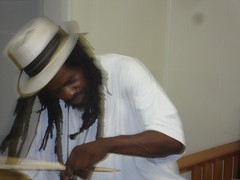
Chappell.Hardy.Trudeau improv, Shreveport / photos Cassie Tobin Chappell
Originally uploaded by trudeau
1. Preparing students to excel in college via written composition, vocab and arts background.
2. Enhancing the skill of evaluative, descriptive writing. There will be an emphasis on critical reviews (examples at rottentomatoes.com) and comparison essays.
3. Transmitting the canon of basic Western art history and vocab.
4. Participation in arts experiences.
5. Presentations to the class via mixed media.
Homework in advance of every class:
Read This web site.
Brief quiz questions will be designed to keep your reading current (3 - 5 pts).
This site will function as the textbook. My entries are typically based on citations from Wikipedia, the NY Times, World Book, Newsweek & Time, museum sites and numerous books, both from my personal and public libraries.
You should find attribution with each entry. And I will expect you to document All of your work for this class, too.
Notebook
Since I illustrate all the notes delivered in class lectures, a sketchbook would be appropriate for the notebook in this class. You see, despite your level of fluency in drawing, I will expect you to do much in copying the illustrations.
Additional points may be earned by students who capture the notes and other work in an artful and colorful sketch book.
Use of color, collage, photography and non-traditional media (watercolor, 3-D paper, etc) are encouraged in notes and projects.
Questions will be quickly attended to at trudeau11@gmail.com.
Fees
Field trip costs must be born by parents and students. Our basic trips will be to Norton, Meadows and La State museums and to Artspace. I will collect a $10 fee prior to our first sortie - in September.
Testing and project schedule
- One multiple choice, open notes quiz per unit or every 3 weeks (about 15 pts).
- One 300-word essay - using class guidelines - in each period (about 15 pts).
- One mixed media presentation in each period (15 pts).
Subscribe to:
Posts (Atom)
